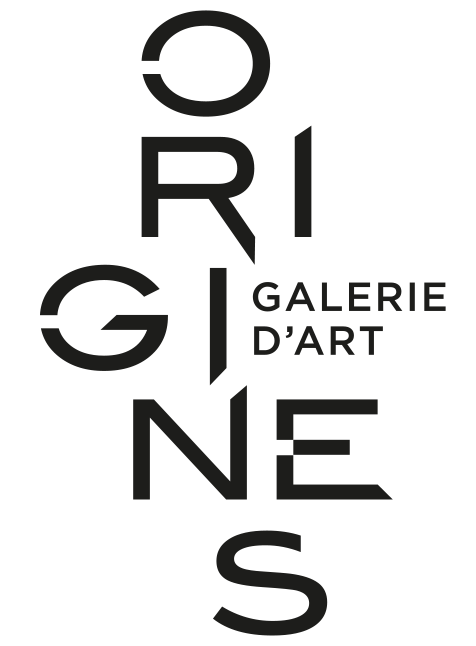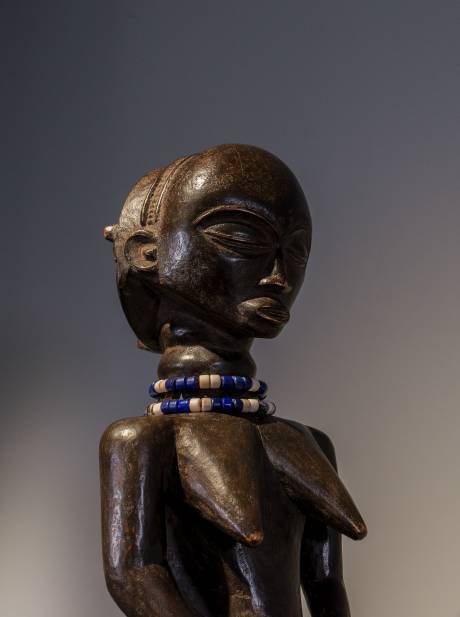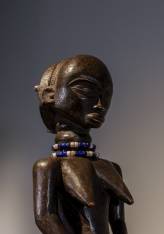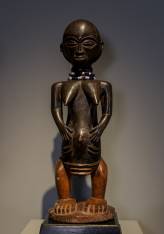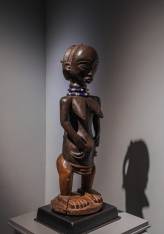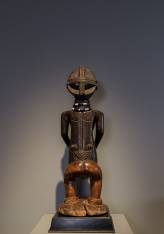Luba, Statue cultuelle.
Luba, Statue cultuelle.
François Neyt, a Benedictine monk from the Monastery of Saint-André de Clerlande (Ottignies - Louvins-la-Neuve, Belgium), was born in Likasi (Zaire) and lived in Africa for twenty years.
He holds a doctorate in philosophy and literature from the Catholic University of Louvain and has been trained in achaeology and art history. He was a professor of African arts at the National University of Zaire (Lubumbashi Campus).
We reproduce here the study carried out by François Neyt, in the text.
Historical and cultural context
The birth of the Luba kingdom around the sixteenth century took place in the center of the Upemba depression: these are the Central Luba, better known as the Shankadi Luba. The Kasai Luba (Western Luba) spread westward; the Eastern Luba lived north and east of the Upemba depression. They extended their influence as far as Lake Moero up the banks of the Luvua River and beyond the Lukuga River, the outlet of Lake Tanganyika. Prince Buki, exiled by King Kumwimbe Ngombe who reigned from 1810 to 1840, multiplied the signs of power, granting the great local chiefs the right to adorn themselves with regalia: scepters, caryatid seats, and cult and ancestral effigies.
Luba art profusely illustrates the body of the woman standing, sitting with her legs outstretched, squatting or kneeling. She is there to transmit life and the Luba traditions. Sculpting her entire body or her face is an act of the highest spirituality, for through her representation the beliefs and history of a people are expressed. The sculptures are divided into the following three areas: woman and the sacred; woman and politics; woman and daily life. Indeed, she is the support of the energies and forces of the ancestral spirits that inhabit and traverse the universe. She is at work, in a secret way, in the political life of the kingdom, as well as in that of the local chiefs and villages; she presents herself in everyday life as the guarantor of the present and the future, while watching over the memory of the kings and chiefs who have passed away.
Female figurines and cup bearers are part of the first theme presented: women and the sacred. Several female sculptures, rarer when one considers the whole of Luba production, illustrate the woman and the Vidye genies, forces of the cosmos and the presence of the ancestors. She is present in a fullness of form, an expression of contained strength and interiority, with a refined hairstyle, eyes that are often half-closed and open to another world, scarifications and sensual lines, hands on her breasts, ready to welcome the spirits, to attract them and to invoke their presence.
The cup bearers, important signs of the Luba divinatory traditions, constitute another original sign of female identity, a support and vector of mystical forces from
elsewhere. A kneeling or seated woman holds a calabash or divination cup between her hands and knees. This is often filled with white powder, the mpemba, which is used to call, invoke and beg the spirits and genies (vidye) of the universe to come and answer her intercession.
The production workshops are numerous; the morphological and stylistic features are recognizable in the overall posture of the woman, the position of the legs and even the feet folded under the heels, the hairstyle, the scarifications, the shape of the haircut. The examples presented are significant of certain workshops and illustrate them admirably. The nomenclature of the cup bearers oscillates mainly between two names: kabila and mboko. Kabila literally means «she who implores, she who calls».
The seer summons the spirits and genies that inhabit the universe and begs them to respond. The other term is Mboko which means the arm. This image of the human body links the heights of the sky to the depths of the earth: with her outstretched arms holding the cup, the Luba woman seems to break the starry vault of the sky and convince the vidye genies to reside for a moment in the receptacle of the cup in order to answer current questions. Other instruments appear during divination: statuettes, cups, calabashes, earthen pots, divinatory frames and cephalomorphic mortars.
In the political world, another theme of presence, the woman keeps an eminently confidential role in the shadow of power. Numerous regalia bear witness to her presence: spear, arrow holder, axe or adze, sceptre, caryatid seat. It is not surprising, finally, that the third theme is that the woman is suggested on objects of daily use: combs, hairpins, ivory or wooden amulets. In the Luba symbolic universe, she is truly the one who brings life into being; she is the obligatory passage of the spirits, the genies and the ancestors.
Female representation among the Luba appears in the field of worship and divination. She watches over the integrity of the royal person, the kingdom and each village in a more secret way. She undoubtedly plays an economic, social and political role. Finally, she appears in the cycle of day and night, the return of the new moon and the seasons, in the cycle of life and death. The feminine representation always asserts itself as an initiatory secret. It is the door that opens onto an elusive reality that touches the mystery of existence.
Provenance
Collected in Kamina in Katanga, this statue belonged to a Mr Augustin BECQUET, engineer-agronomist and Director at the INEAC and mining engineer at the Union Minière du Haut Katanga (UMHK). In 1918, he studied at the Catholic University of Louvain and graduated in 1921.
He was hired in Tshikapa, at the headquarters of La Forminière, and in 1924 he was sent to the Kanda-Kanda region among the Kanyok. He was given many missions in Bukama, Kamina and Mutombo-Mukulu (near Kaniama). After a leave of absence in Belgium, he returned to the Congo in October 1930. During the war, he took refuge in Angola and then returned to INEAC. This statue has remained in his family by descent. It was recently acquired by Mr. Patric Claes in December 2018. On the base pedestal whose growth circles are very old read the following engraved letters: A. BECQUET and further on BECK.
Description
Carved in a medium-heavy wood, this female statuette is in a standing posture, with her hands resting on her stomach. The wood is covered with a dark patina on the head and the whole body; it is lighter around the loins which must have been wearing a loincloth.
The effigy, rare among the Luba, is 54 cm high. The ovoid face with its full forms develops the volume of the forehead, a sign of wisdom and knowledge. The eye sockets are hollowed out like almonds and are topped by a prominent eyebrow. The half-closed eye accentuates the slightly globular volume of the upper eyelid. The triangular nose, at the junction of the superciliary arches, has a straight bridge and clearly developed wings. As for the mouth, prognathic, it is inscribed in a broad oval, the fleshy lips, the apparent tongue. The auricle is almost circular, with the tragus protruding from the center.
An ancient copper stud is implanted in the middle of the tiara. The tiara is decorated with small parallel grooves inscribed between two curved and protruding lines forming its frame, which holds a circular headdress that curves to the back. In the past, in the eastern tradition of the Tabwa, Tumbwe and Hemba, this concave space was used by the village chief to deposit the seeds for the next crop after the dry season. These seeds were placed in a small raffia bag with a rectangular shape as shown in several effigies of Hemba ancestors.
The cruciform headdress connects two large horizontal, curved braids passing over two vertical braids. Each braid consists of two rows of chevrons connecting to a central line. The space protected by these braids is remarkable. The neck is cylindrical and marked by two bulges. It bears the traditional necklace made of white and dark blue glass beads. The plane of the shoulders is horizontal, already reflecting isometric dimensions by the posture of the upper arms.
The body has a volume that rounds out in front and blossoms into a bulbous belly, revealing the pregnant woman with a prominent navel ending in a pastille. The pear-shaped and oblong breasts are generous and fall to the intersection of the elbow. The arms, slightly spread, wrap the trunk and the forearms are extended by a realistic hand placed on either side of the umbilical zone. Note the double curvilinear keloids superimposed on each side of the lower abdomen, announcing the three keloids of the lower abdomen which end with the small lips open downwards. Remember that the keloids are incisions in which charcoal (makala) is placed, which are covered and closed.
The back is also remarkable for the hollowed spine and two curvilinear lines stylizing the shoulder blades. At the level of the loins appears a triangle composed of small V-shaped lozenges reflecting the moment when the new moon comes to fertilize the earth and the woman, as the lozenge expresses the meeting of heaven and earth. Above the triangle, three small vertical and swollen scarifications are placed on each side.
The rounded buttocks are prolonged by cylindrical lower limbs. These rest on large snowshoe-like feet with drawn toes. Two copper staples are fixed in the middle of the right foot and on the base to prevent the ancient crack from becoming more pronounced. The base is cylindrical and flat.
Use, style and dating
Female effigies are rare. The cultural context in which they are placed allows us to better understand their use and meaning. Two aspects should be noted first:
Among the central Luba, the woman places her hands on her breasts as a sign of fertility: she is the nurturing woman. It is she who feeds her child, but also her people; it is she who is the intermediary between the vidye genies, the forces of nature and the ancestors. It is through her that life passes.
Among the Eastern Luba, the woman often puts her hands on her abdomen, watching over the child she is going to give birth to. She is fertile and parturient. This attitude of protecting the child is traditional among the Hemba, where ancestor figures usually place their hands near the umbilical area. This is a sign that the chief of the village or clans concerned is protecting his people and watching over them.
A third interpretation is possible, linked to divination or a cult: the pregnant female effigy is venerated to protect women who are about to give birth, to promote fertility (perceptible in the keloids and scarifications), and to avoid illness and death.
It is useful to remember that the kifwebe masks of the Luba are sources of discernment and appear during the neomenias to promote the fertility of the woman and to put her in contact with the beneficial spirits. In the Luba statue presented, is it a princess linked to the statuary of the ancestor, or a woman who enjoys a magic-religious authority, seer or diviner, a cult sign of protection?
This is more likely and frequent among the Luba. In this case, it would be a cult effigy. But it is difficult to specify to which cult the sculpture dates.
Other signs are significant for the location of this Luba female effigy. This is the development of the genitals. Among the Lubais peoples near the sources of the Luvua, seats with caryatids present sculpted women whose sex is placed on the ground, linking the fecundity of the woman to that of the earth and agriculture. The female arrowhead made by the Master of Sopola has many comparable morphological features: four-lobed hairstyle, almond-shaped eyes, pear-shaped breasts, abundant scarifications, keloids around the sex.
This female statue seems to us to be close to the effigies of ancestors that are frequent in Hema country. It carries within it all the benevolent magic of the eastern Luba. It can be dated to the beginning of the 20th century.
We can therefore situate the female sculpture in the Kifwa region on the upper Luvua, a few kilometers from Lake Moero. This region had remarkable sculpture workshops (1).
(1) in Neyt François, Luba. Aux sources du Zaïre, Musée Dapper, Paris, 1993-1994.
p.66 (figure) and 67
